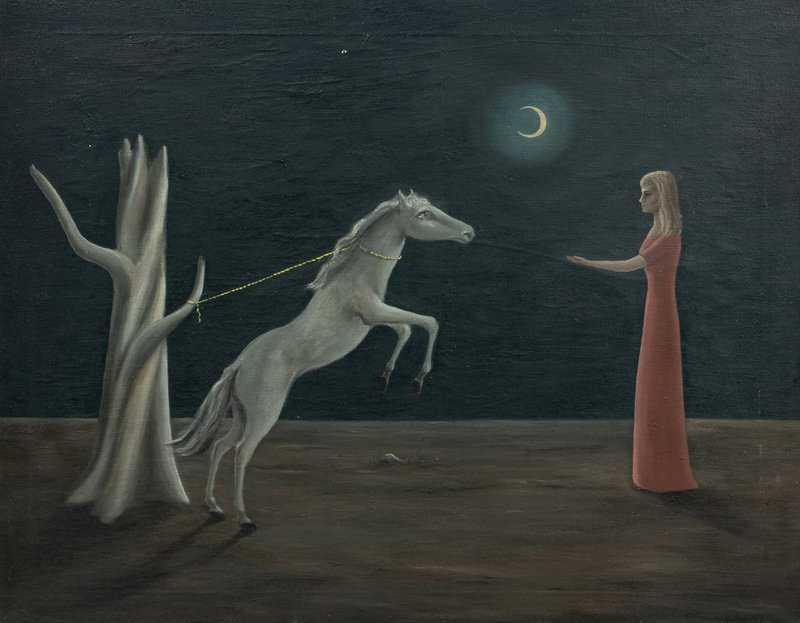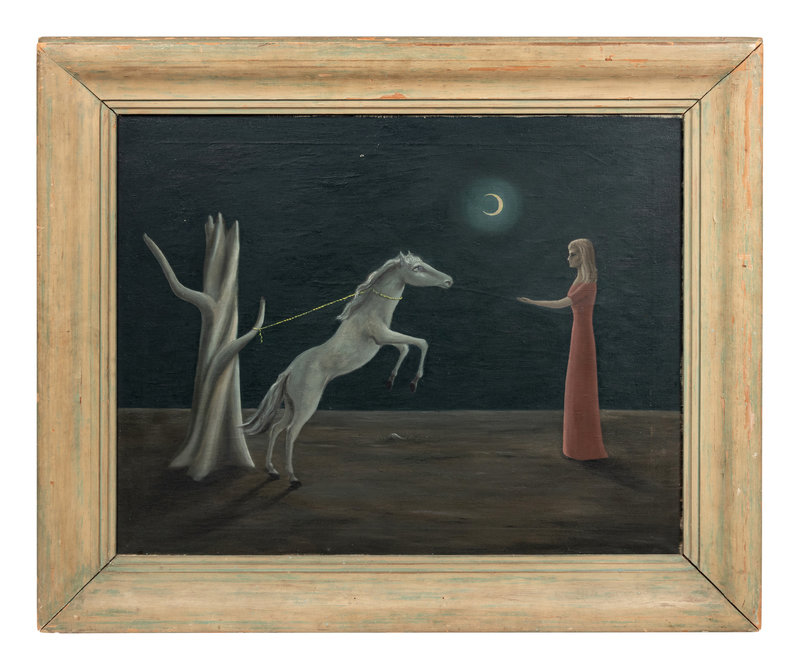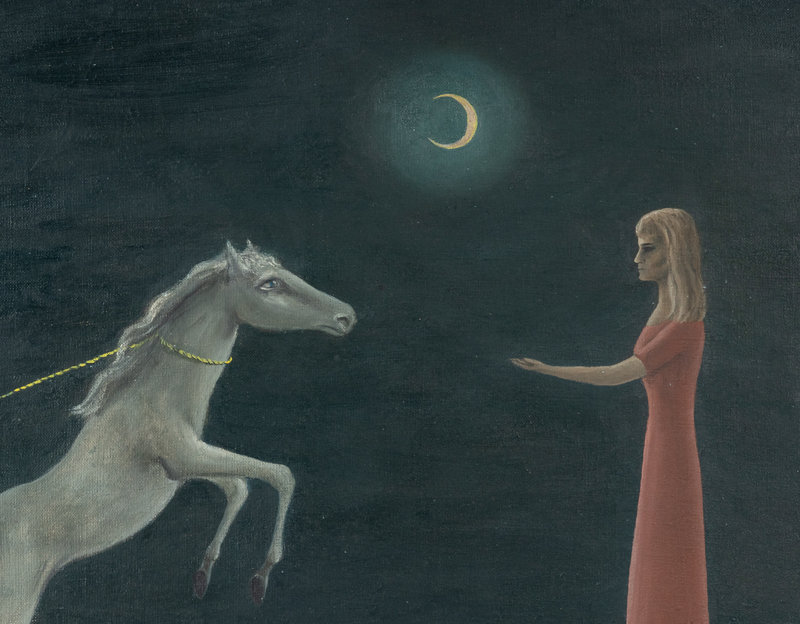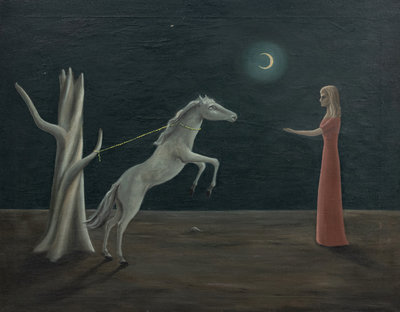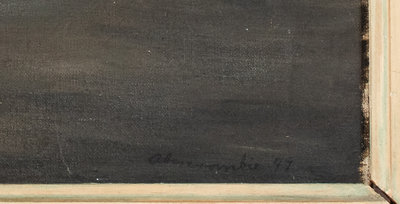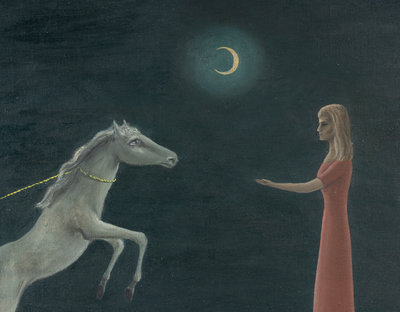Lot 4
Gertrude Abercrombie
(American, 1909-1977)
Untitled (Woman with Tethered Horse and Moon)
, 1947
Sale 1114 - Post-War & Contemporary Art
Dec 14, 2022
10:00AM CT
Live / Chicago
Own a similar item?
Estimate
$80,000 -
120,000
Price Realized
$437,500
Sold prices are inclusive of Buyer’s Premium
Lot Description
Gertrude Abercrombie
(American, 1909-1977)
Untitled (Woman with Tethered Horse and Moon)
, 1947oil on canvas
signed Abercrombie and dated (lower right)
23 x 28 inches.
This lot is located in Chicago.
Provenance:
The Artist
Private Collection, gift from the Artist
Thence by descent through the family
Lot Essay:
If Wishes Were Horses
Painted in 1947, Untitled (Girl and Horse Tethered to a Tree), includes several elements typical of Gertrude Abercrombie’s work—a solitary woman (Abercrombie herself) in a landscape devoid of anything but a single, leafless tree, a white horse, and a crescent moon. These elements are arranged in the artist’s distinctive manner to create a mysterious and evocative composition. Beginning in the late 1930s, the white horse starts to appear in Abercrombie’s oeuvre. One of the earliest examples is seen in The Hill (1938, Private Collection) a bucolic landscape characteristic of the regionalist work of the period. The artist continued on to execute a number of paintings with white horses as their focus. But these were not only explorations of a kind of subject popular at the time—Abercrombie rarely addressed a theme that had no personal aspect. The artist spent part of her childhood in the small midwestern town of Aledo, Illinois. As an only child with very strict parents, it was here she was able to enjoy the company of a large extended family of grandparents, aunts, uncles, and most of all, cousins (with whom she remained close all her life). The lush calm of these early landscapes recalls the warm memories of her long summer visits and the welcoming embrace of her family, while at the same time conforming to the ubiquitous images of the American Scene.
The cheerful landscapes of the late 1930s were replaced by more somber and ominous settings by the early 1940s, and the white horse takes on a different role. In 1941, she married Bob Livingston and subsequently painted Girl Leading Horse (Private Collection), an image of Abercrombie guiding a large white horse along a path in a dark landscape. As in Untitled (Girl and Horse Tethered to a Tree), the relationship between the woman and the horse is the subject of the work. According to Abercrombie’s daughter, Dinah, the white horse always represents Bob; in Mrs. Livingston’s letter of 1980 she suggests that the horse may symbolize Bob as well. Could the docile horse that she leads peacefully down the path and the feisty horse she is trying to tame in Untitled both refer to her husband? The earlier painting may reflect a calm moment at the marriage’s beginning, albeit one in which Gertrude is clearly in charge. Significantly, Untitled was painted at the time the marriage was dissolving, which makes the attempt to dominate an unruly animal understandable.
Even if the horse represents Bob in some sense, Abercrombie’s work cannot be reduced to a simple formula. Like much of her best work, the painting has an eerie, enigmatic quality. The female figure reaches out to the horse, whose almost human eyes echo her own, as if to control it magically. At the same time, the horse rears gracefully but is restrained by the elegant, slim rope tied to a broken branch on the dead tree. Several themes that Abercrombie treated in other works resonate with this painting. Magically controlling animals is the subject of works like Owl Trainer (1945, Private Collection) and the theme of artificial restraint is explored in works such as Self Imprisonment (1945, Private Collection). She even combines the themes in works such as Snared (1967, Private Collection). Ultimately, it has the effect of making communication impossible, and that may be source of the power of this image.
Other images of white horses appear in different, more mysterious circumstances, often seen peering through a window into a typical austere interior. See, for example, Horse and Sugar Cube, 1945 (location unknown) and The Fortune Teller (1951, Peoria Riverfront Museum, Peoria, Illinois). Again, these images suggest an inability to connect, one of Abercrombie’s most potent themes.
Additionally, the present artwork is accompanied by an interesting provenance. It was given as a wedding present to Jean and Irvin Livingston, Jr., brother and sister-in-law of Gertrude’s husband, Bob Livingston. The painting became the de facto possession of Mrs. Nathan Zimmerman, Bob’s sister, to whom it was loaned. According to Mrs. Jean Livingston, in a letter to Susan Weininger, dated February 11, 1980, Mrs. Zimmerman could not part with it when the Livingstons moved from Illinois to California in 1958. It came by descent into the possession of the current owner. The remnant of an Associated American Artists label remains on the frame, but it is doubtful that this painting was exhibited either in the New York or Chicago Gallery, which opened in 1945, and more likely the result of reusing a frame that was previously on a painting exhibited there. The label is carefully torn so that there is nothing visible to identify a particular work. Mrs. Livingston, in her 1980 letter, said that the painting “came right off Gertrude’s easel” to them.
Untitled (Girl and Horse Tethered to a Tree) is classic Abercrombie, beautifully executed, haunting, mysterious, nuanced, and capable of being understood on multiple levels, allowing for endless viewing.
Susan Weininger
Professor Emerita
Roosevelt University
Condition Report
Contact Information
Auction Specialist
